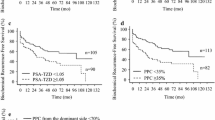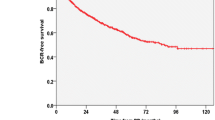Abstract
To assess preoperative parameters that may be predictive of pathologic stage T2a (pT2a) and pathologic Gleason score (pGS) ≤ 6 disease in low-risk prostate cancer patients considering active surveillance. A cohort of 1,495 men with low-risk prostate cancer between 1993 and 2009 was utilized. Preoperative assessment focused on patient age, race, diagnostic PSA level, clinical stage, diagnostic biopsy Gleason score, and prostate cancer laterality. Kaplan–Meier curves and a Cox regression model were used for analysis of PSA recurrence. Preoperative parameters were analyzed by univariate and multivariate logistic regression methods. Of 1,495 patients, 187 (12.5 %) were identified with pT2a and pGS ≤ 6 disease. Of the 187 men with pT2a and pGS ≤ 6 disease, only 6 (3.2 %) cases had PSA recurrence. Kaplan–Meier PSA recurrence-free survival curves identified a difference between prostate cancers with pT2a and pGS ≤ 6 and prostate cancers with >pT2a or pGS ≥ 7 disease (p = 0.002). Only biopsy tumor unilaterality (OR, 10.452; p ≤ 0.001) and low diagnostic PSA levels (OR, 0.887; p = 0.003) were independent predictors of prostate cancers with pT2a and pGS ≤ 6 disease on univariate and multivariate logistic regression. Biopsy tumor unilaterality and low diagnostic PSA levels are the independent predictors of pT2a and pGS ≤ 6 disease in low-risk prostate cancer patients. Unilateral cancer by prostate biopsy and low diagnostic PSA level may be the reference to improving the selection of appropriate candidates for active surveillance within a low-risk prostate cancer cohort.

Similar content being viewed by others
References
Klotz L. Active surveillance for favorable risk prostate cancer: what are the results, and how safe is it? Semin Radiat Oncol. 2008;18:2–6.
Carroll PR. Early stage prostate cancer-do we have a problem with over- detection, overtreatment or both? J Urol. 2005;173:1061.
Stattin P, Holmberg E, Johansson JE, Holmberg L, Adolfsson J, et al. Outcomes in localized prostate cancer: national prostate cancer register of Sweden follow-up study. J Natl Cancer Inst. 2010;102:950–8.
Telesca D, Etzioni R, Gulati R. Estimating lead time and over diagnosis associated with PSA screening from prostate cancer incidence trends. Biometrics. 2008;64:10–9.
Cooperberg MR, Broering JM, Kantoff PW, Carroll PR. Contemporary trends in low risk prostate cancer: risk assessment and treatment. J Urol. 2007;178:14.
Carter HB, Kettermann A, Warlick C, Metter EJ, Landis P, et al. Expectant management of prostate cancer with curative intent: an update of the Johns Hopkins experience. J Urol. 2007;178:2359–64.
Dall’Era MA, Konety BR, Cowan JE, Shinohara K, Stauf F, et al. Active surveillance for the management of prostate cancer in a contemporary cohort. Cancer. 2008;112:2664–70.
Soloway MS, Soloway CT, Williams S, Ayyathurai R, Kava B, et al. Active surveillance; a reasonable management alternative for patients with prostate cancer: the Miami experience. BJU Int. 2008;101:165.
Klotz L. Active surveillance for prostate cancer: trials and tribulations. World J Urol. 2008;26:437–42.
Ali K, Gunnar A, Jan-Erik D, Hans L, Par L, et al. PSA doubling time predicts the outcome after active surveillance in screening-detected prostate cancer: results from the European randomized study of screening for prostate cancer Sweden section. Int J Cancer. 2007;120:170–4.
Patel MI, DeConcini DT, Lopez-Corona E, Ohori M, Wheeler T, et al. An analysis of men with clinically localized prostate cancer who deferred definitive therapy. J Urol. 2004;171:1520–4.
D’Amico AV, Whittington R, Malkowicz SB, Cote K, Loffredo M, et al. Biochemical outcome after radical prostatectomy, external beam radiation therapy, or interstitial radiation therapy for clinically localized prostate cancer. JAMA. 1998;280:969–74.
Klotz L. Active surveillance with selective delayed intervention for favorable risk prostate cancer. Urol Oncol. 2006;24:46–50.
Conti SL, Dall’era M, Fradet V, Cowan JE, Simko J, et al. Pathological outcomes of candidates for active surveillance of prostate cancer. J Urol. 2009;181:1628–33.
van den Bergh RC, Vasarainen H, van der Poel HG, Vis-Maters JJ, Rietbergen JB, et al. Short-term outcomes of the prospective multicentre ‘Prostate Cancer Research International: active surveillance’ study. BJU Int. 2010;105:956–62.
O’Brien MF, Cronin AM, Fearn PA, Smith B, Stasi J, et al. Pretreatment prostate-specific antigen (PSA) velocity and doubling time are associated with outcome but neither improves prediction of outcome beyond pretreatment PSA alone in patients treated with radical prostatectomy. J Clin Oncol. 2009;27:3591–7.
Pelzer AE, Colleselli D, Bektic J, Steiner E, Ramoner R, et al. Pathological features of Gleason score 6 prostate cancers in the low and intermediate range of prostate-specific antigen level: is there a difference? BJU Int. 2008;101:822–5.
Hong SK, Han BK, Lee ST, Kim SS, Min KE, et al. Prediction of Gleason score upgrading in low-risk prostate cancers diagnosed via multi (> or = 12)-core prostate biopsy. World J Urol. 2009;27:271–6.
Onik G, Miessau M, Bostwick DG. Three-dimensional prostate mapping biopsy has a potentially significant impact on prostate cancer management. J Clin Oncol. 2009;27:4321–6.
Davis JW, Kim J, Ward JF, Wang X, Nakanishi H, et al. Radical prostatectomy findings in patients predicted to have low-volume/low-grade prostate cancer diagnosed by extended-core biopsies: an analysis of volume and zonal distribution of tumour foci. BJU Int. 2010;105:1386–91.
Conflict of interest
The authors declare no conflict of interest.
Author information
Authors and Affiliations
Corresponding author
Rights and permissions
About this article
Cite this article
Fu, Q., Moul, J.W., Bañez, L. et al. Preoperative predictors of pathologic stage T2a and pathologic Gleason score ≤ 6 in men with clinical low-risk prostate cancer treated with radical prostatectomy: reference for active surveillance. Med Oncol 30, 326 (2013). https://doi.org/10.1007/s12032-012-0326-5
Received:
Accepted:
Published:
DOI: https://doi.org/10.1007/s12032-012-0326-5




